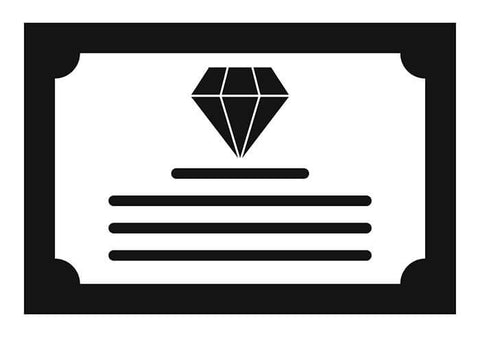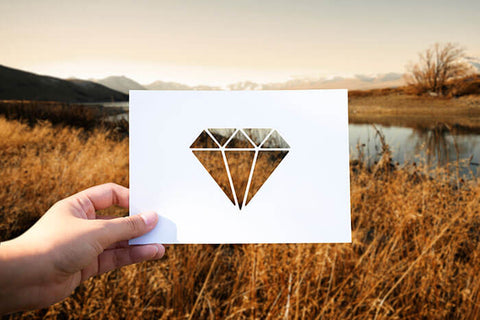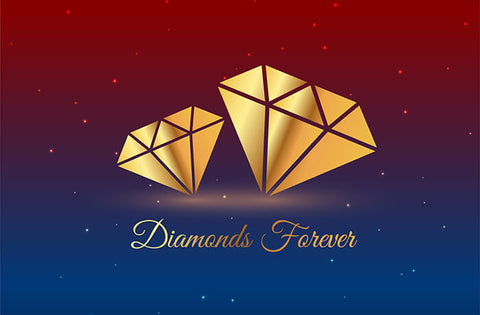IGI vs. GIA: Which Diamond Certification is Best?
The certification of a diamond thoroughly analyses its attributes, including the four Cs: carat weight, colour, clarity, and cut quality. Notably, one of the foremost authorities in this field is the Gemological Institute of America (GIA). The ultimate grade of a diamond has a big effect on how much it costs. To be sure you're paying a fair price for the diamond's actual quality, always ensure the one you're considering has a reputable lab certification.
Everything you need to know about diamond certification is covered in this article, including the possibility that the certificate holds greater significance than the four Cs it grades.
Diamonds are given a grade or certification that expresses different facets of their quality. Before being sold, every stone is meticulously examined and sent to grading labs for additional analysis. The distinctions between GIA and IGI diamond certifications will be examined in this article.
How Does Diamond Certification Work?
Gemological laboratories that have been accredited, like the Gemological Institute of America (GIA), issue diamond certificates, also known as grading reports. A diamond's carat weight, colour, clarity, and cut quality are the four Cs that determine a diamond's grade. This information is contained in the diamond certificates. The diamond's final grade has a significant impact on its cost.

You should obtain and examine the lab certification for each diamond you consider buying. A grading body will issue this lab report or certificate, which lists the diamond's colour, clarity, length, and width, among other characteristics. Skilled experts use instruments like a loupe or microscope to assess, examine, and measure the diamonds.
IGI: What Is It?
The internationally renowned International Gemological Institute (IGI) offers grading reports for jewellery, coloured stones, and diamonds and conducts gemological research and education. Founded in 1975, the company has locations in prominent global hubs for diamonds and jewellery, such as New York, Antwerp, Mumbai, Bangkok, and Hong Kong.
The IGI is renowned for evaluating jewellery and gemstones using cutting-edge machinery. Their reports offer details on the attributes, worth, and condition of the things being graded; this information can be utilised for sales, insurance, and other purposes.
Apart from providing grading services, the IGI conducts research and development in gemmology and provides professional and enthusiastic courses and workshops.
IGI Certification: What Is It?
An extensive inspection and assessment of a gemstone or piece of jewellery is required for IGI certification to ascertain its authenticity and quality. The stone's colour, clarity, cut, carat weight, and potential treatments or enhancements are all considered during the grading process.
IGI certification gives buyers a trustworthy and impartial evaluation of a gemstone's quality, assisting them in making wise purchases. By offering a standardised method for assessing and grading gemstones, it also aids in preventing fraud and misrepresentation in the gemstone industry.
GIA: What is it?
Regarding pearls, coloured stones, and diamonds, the world's foremost authority is the nonprofit Gemological Institute of America (GIA). Founded in 1931, the company is headquartered in Carlsbad, California, USA, and has additional locations in significant diamond and jewellery hubs across the globe.
By offering fair and accurate grading reports, education to consumers and industry professionals, and industry oversight, the GIA is committed to upholding public confidence in gems and jewellery. Through education, research, laboratory services, instrument development, and setting and upholding the highest standards of academic integrity, science, professionalism, and science, it seeks to protect consumers of gems and jewellery.
Among the many educational opportunities the GIA provides, the Graduate Gemologist (GG) programme is regarded as the industry's most prestigious certification. The four Cs—carat weight, colour, clarity, and cut—are the diamond grading system used by the Gemological Institute of America (GIA). This system, which is widely accepted, has evolved into the industry standard for characterising diamonds.
GIA Certification: What Is It?
Gemstone certification, which thoroughly assesses a gemstone's quality and characteristics, is one of GIA's most well-known services. The GIA certification process includes a comprehensive examination of the gemstone using various methods, such as visual inspection, gemological testing, and analysis of the stone's physical and chemical properties.
A comprehensive report on the quality and attributes of the gemstone, including details on its weight, size, colour, clarity, and cut, is provided in the GIA certificate produced as a result. When buying or selling gemstones, this information can be helpful for both customers and business professionals because it offers an unbiased assessment of the stone's quality and can help determine its market value.
The diamond grading authority that is most widely recognised and well-respected is the Gemological Institute of America or GIA. They offer the highest consistency and peace of mind when buying any diamond.
GIA grades diamonds according to several attributes and considerations, including:
Date of Diamond's evaluation
Units of measurement: millimetres
Diamond shape and cutting style
Carat mass
Table % Depth %
Size of culet
Equilibrium
Diagram of proportions
Polish standard
Girdle depth
Cut score (Very Good, Good, Poor, Excellent)
Colour classification (from D to J),(IF, VVS1, VVS2, VS1, VS2, SI1, SI2) for clarity grade
The diamond plot displays every inclusion and imperfection.
Grade of fluorescence
Inscription by laser (if applicable)
Features of security
General remarks
What Distinguishes GIA From IGI Diamond Certifications?
Two of the most respected and well-known diamond certification agencies in the world are IGI and GIA. Diamond grading reports, which provide details about a diamond's quality and characteristics, are offered by the GIA and IGI. There are, nevertheless, certain distinctions between the two certifications.
Grading Guidelines:
The grading guidelines for IGI and GIA are somewhat different. GIA is renowned for its rigorous grading system and is regarded as the industry standard.
Grading System:
The two organisations grade diamonds using a system that considers the four Cs: colour, clarity, cut, and carat weight. But IGI gives more weight to the diamond's cut, whereas GIA gives more weight to the diamond's colour and clarity.
Report Format:
The reports have distinct formats as well. A more comprehensive report with extra details like polish, symmetry, and fluorescence grades is offered by IGI. The GIA report is shorter and mostly concentrates on the 4 Cs.
Cost:
The two organisations may charge different certification fees. IGI certification typically costs less than GIA certification.
In conclusion, there are some distinctions between IGI and GIA in terms of grading standards, methodology, report format, and cost, even though both are respectable certification bodies. The two decisions ultimately concern the buyer's priorities and personal preferences.
Which Is The Best Diamond Certification? GIA or IGI?
Reputable diamond grading laboratories that offer precise and trustworthy diamond certification are IGI and GIA.
However, GIA is widely regarded as the more esteemed and well-established organisation, and it has a standing for having the strictest grading guidelines in the business. The GIA is frequently regarded as the industry standard for diamond grading, and its certifications enjoy global recognition and respect.

Ultimately, trustworthy organisations offering trustworthy diamond certification services are IGI and GIA. The decision between the two may depend on the individual's unique needs, requirements and personal preferences.
Analysing Grading Reports—GIA or IGI
Diamond purchasers should closely examine the following information in a grading report in addition to the 4Cs (complete grading reports from both GIA and IGI should contain this information):
Measurements:
By dividing the length by the width of the diamond, you can calculate the length-to-width ratio of a diamond. These details display the surface area of a diamond.
Fluorescence:
is regarded as a diamond's fifth C. Therefore, buyers shouldn't overlook it. The best action is to steer clear of fluorescence; in diamonds with H or lower colour grades, neither faint nor medium blue can be useful.
Inscription:
The presence of a laser-etched diamond grading report number on the diamond's girdle—an optional extra measure for safety—will be indicated in this section.
Comments:
This section is essential for learning more about the diamond's enhancements, clarity type, and other specifics.
Proportions:
This section's information is essential for determining the diamond's cut quality. It displays the exact dimensions of a diamond's cut. Examine our guides for each shape to determine the diamond's cut quality.
Clarity Characteristics:
Information regarding the kinds of inclusions and where they are located within the graded diamond is provided in this section.
Why Is This Important for the Consumer?
To ensure that the diamond you purchase is as high-quality as the seller claims, you must purchase a legitimately certified diamond. This enables you to ensure you receive a fair deal by comparing the diamond to other diamonds of a similar calibre.
In the words of GIA, the global leader in certification, "The GIA Diamond Grading Report is similar to house deeds or vehicle registrations in that it offers information on your purchase, which can be used to determine the value of the purchase."
How Do Diamond Trade Companies Handle the Circumstance?
Those working in the diamond industry, who witness daily declines in margins and increased competition, have my understanding and sympathy. Unfortunately, rather than finding a different way to boost their margins, far too many have chosen to resort to deceit and manipulation (by providing unique experiences or special products).
You may believe things like "you are cherry-picking diamonds for a certain result" or "this is just your opinion; others may have a different one," but those things are untrue. Diamond companies can selectively select the results to use the looser certificates with the highest grade inflation.
This is yet another "trick" they employ. We have found that some IGI laboratories are not as strong as others. Many American jewellers will comment, "Oh, those articles discuss IGI in Botswana, Mumbai, or Antwerp." The NY IGI lab is far more stringent.
In a sense, that is accurate. Sadly, those same jewellers can also pull off a simple ruse. One possible solution would be to send a diamond with an IGI Mumbai (or Botswana, or wherever) certificate along with it to IGI NY.
After that, you'll receive a certificate, and your grades from their sister lab will be "honoured" by the stricter IGI lab in New York.
We sent these five diamonds to IGI in New York to verify this rumour. There was no laser inscription from the IGI labs in Mumbai on three of the diamonds. There were laser inscriptions from IGI Antwerp on two of them.
The two inscriptions were sent with the certificates from IGI Antwerp, and the three that did not were sent as "new diamonds." IGI New York matched the extremely generous grades from IGI Antwerp on the other two stones but predictably downgraded the three "new diamonds" from their prior grades from IGI Mumbai.
In what way does that indicate their credibility? What does that say about an IGI-using jeweller?
IGI Antwerp's grades were honoured by IGI New York unless this was a miraculous coincidence. How does this benefit the customer or their credibility as a stand-alone laboratory?
Reputable laboratories do not allow anything to affect their grade; for example, GIA will not accept packaging with any markings other than your SKU number and weight, and they will not allow you to inform them of the grades of another GIA laboratory to sway their judgment.
Final remarks
Even though IGI is a trustworthy lab, it is still not as consistent as GIA, though the former should not be completely disregarded. The best course of action might be to operate under the presumption that there may be a small discrepancy in the clarity and colour of the diamond between the IGI and GIA.
If you are purchasing IGI-graded diamonds, purchase those with a complete IGI report rather than the mini-reports, which lack information about the cut and fluorescence. Furthermore, buying an IGI diamond with lab reports from their more reputable labs in the United States and Europe could be a good idea. Remembering that IGI is more reliable for low-grade diamonds than high-grade ones is also critical.
Every LBJ diamond has its origin and quality attributes independently confirmed. We include diamond certificates or grading reports from independent gemmology labs, which provide professional opinions on the quality of the diamond, on every diamond product page.
Expert gemologists assess the diamond's cut, colour, and clarity in addition to measuring its weight and dimensions using specialised equipment. The leading gem grading laboratories in the world, including GIA, IGI, HRD, and GCAL, have certified our diamonds. Don't hesitate to contact us if you want an electronic copy of a diamond lab certificate.
If you are a first-time buyer, our best recommendation would be to forego the risk entirely and choose a diamond that has been GIA-certified.
We advise you to acquaint yourself with the four scenarios buyers contemplate while shopping and the seven variables influencing a diamond's price as you search for the ideal stone.
The seven factors are the diamond's shape, carat weight, colour, cut, clarity, fluorescence, and certification.
Frequently Asked Questions Regarding Diamond Certification
To what extent does diamond certification matter?
Any diamond must have certification because it attests to and describes your purchasing item. You can't tell if the diamond you're purchasing is what the seller says without a certificate from an accredited lab. Information about the cut quality, colour grade, carat weight, and other attributes are included in a diamond certificate. It is crucial to have evidence for the items you purchase, particularly when making a major purchase, like a diamond.

Is a certificate really necessary for my diamond?
A certificate is necessary for your diamond because you can't be sure what you're buying without one. A certificate provides evidence of various characteristics, including clarity, colour grade, carat weight, and cut quality. Without a certificate, you won't even be able to tell if the diamond is real or artificial.
What distinguishes a certified diamond from an uncertified one?
A non-certified diamond lacks a certificate, while a certified diamond has undergone testing by an independent laboratory and has received this certification. Because certified diamonds have undergone verification by a qualified gemologist, they can be trusted more. It can be challenging to determine whether a non-certified diamond's colour and cut quality are as good as the seller says.
